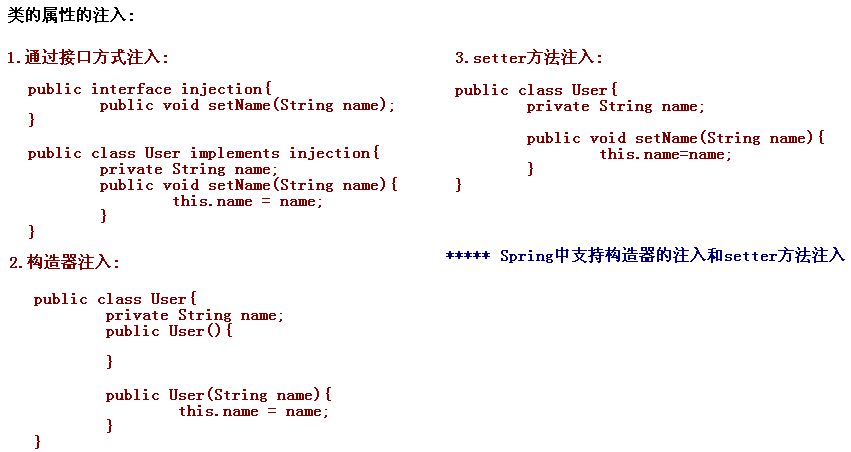IOC装配Bean(XML方式)
Spring框架Bean实例化的方式
提供了三种方式实例化Bean
构造方法实例化(默认无参数,用的最多)
静态工厂实例化
实例工厂实例化
无参数构造方法的实例化
<!-- 默认情况下使用的就是无参数的构造方法. -->
<bean id="bean1" class="cn.yzu.spring3.demo2.Bean1"></bean>
静态工厂实例化
public class Bean2Factory {
public static Bean2 getBean2(){
System.out.println("静态工厂的获得Bean2的方法...");
return new Bean2();
}
}
<!-- 第二种使用静态工厂实例化 -->
<bean id="bean2" class="cn.yzu.spring3.demo2.Bean2Factory" factory-method="getBean2"></bean>
实例工厂实例化
public class Bean3Factory {
public Bean3 getBean3(){
System.out.println("Bean3实例工厂的getBean3方法...");
return new Bean3();
}
}
<!-- 第三种使用实例工厂实例化 -->
<bean id="bean3" factory-bean="bean3Factory" factory-method="getBean3"></bean>
<bean id="bean3Factory" class="cn.yzu.spring3.demo2.Bean3Factory"/>
Bean的其他配置
id和name的区别
id遵守XML约束的id的约束.id约束保证这个属性的值是唯一的,而且必须以字母开始,可以使用字母、数字、连字符、下划线、句话、冒号,name没有这些要求
如果bean标签上没有配置id,那么name可以作为id.现在的开发中一般都使用id
类的作用范围
scope属性
singleton :单例的.(默认的值.)
prototype :多例的.
request :web开发中.创建了一个对象,将这个对象存入request范围,request.setAttribute();
session :web开发中.创建了一个对象,将这个对象存入session范围,session.setAttribute();
globalSession :一般用于Porlet应用环境.指的是分布式开发.不是porlet环境,globalSession等同于session;
实际开发中主要使用singleton,prototype
Bean的生命周期
配置Bean的初始化和销毁的方法
init-method=”setup”
destroy-method=”teardown”
执行销毁的时候,必须手动关闭工厂,而且只对scope=”singleton”有效.
Bean的生命周期的11个步骤
1.instantiate bean对象实例化
2.populate properties 封装属性
3.如果Bean实现BeanNameAware 执行 setBeanName
4.如果Bean实现BeanFactoryAware 或者 ApplicationContextAware 设置工厂 setBeanFactory 或者上下文对象 setApplicationContext
5.如果存在类实现 BeanPostProcessor(后处理Bean) ,执行postProcessBeforeInitialization
6.如果Bean实现InitializingBean 执行 afterPropertiesSet
7.调用<bean init-method="init"> 指定初始化方法 init
8.如果存在类实现 BeanPostProcessor(处理Bean) ,执行postProcessAfterInitialization
9.执行业务处理
10.如果Bean实现 DisposableBean 执行 destroy
11.调用<bean destroy-method="customerDestroy"> 指定销毁方法 customerDestroy
演示(在CustomerService类的add方法之前进行权限校验)
public interface CustomerService {
public void add();
public void find();
}
public class CustomerServiceImpl implements CustomerService, BeanNameAware,ApplicationContextAware,InitializingBean,DisposableBean {
private String name;
public void setName(String name) {
System.out.println("第二步:属性的注入.");
this.name = name;
}
public CustomerServiceImpl() {
super();
System.out.println("第一步:实例化类.");
}
public void add(){
System.out.println("添加客户...");
}
public void find(){
System.out.println("查询客户...");
}
public void setBeanName(String name) {
System.out.println("第三步:注入配置的类的名称"+name);
}
public void setApplicationContext(ApplicationContext applicationContext) throws BeansException {
System.out.println("第四步:注入applicationContext"+applicationContext);
}
public void afterPropertiesSet() throws Exception {
System.out.println("第六步:属性设置后执行...");
}
public void setup(){
System.out.println("第七步:调用手动设置的初始化方法...");
}
public void destroy() throws Exception {
System.out.println("第十步:调用销毁的方法...");
}
public void teardown(){
System.out.println("第十一步:调用手动销毁方法...");
}
}
public class MyBeanPostProcessor implements BeanPostProcessor{
/**
* bean:实例对象
* beanName:在配置文件中配置的类的标识.
*/
public Object postProcessBeforeInitialization(Object bean, String beanName) throws BeansException {
System.out.println("第五步:初始化之前执行...");
return bean;
}
public Object postProcessAfterInitialization(final Object bean, String beanName) throws BeansException {
System.out.println("第八步:初始化后执行...");
// 动态代理:
if(beanName.equals("customerService")){
Object proxy = Proxy.newProxyInstance(bean.getClass().getClassLoader(), bean.getClass().getInterfaces() , new InvocationHandler() {
// 调用目标方法的时候,调用invoke方法.
public Object invoke(Object proxy, Method method, Object[] args) throws Throwable {
if("add".equals(method.getName())){
System.out.println("权限校验...");
Object result = method.invoke(bean, args);
//System.out.println(System.currentTimeMillis());
return result;
}
return method.invoke(bean, args);
}
});
return proxy;
}
return bean;
}
}
public class SpringTest4 {
@Test
// Bean完整的生命周期
public void demo1() {
ClassPathXmlApplicationContext applicationContext = new ClassPathXmlApplicationContext("applicationContext.xml");
CustomerService customerService = (CustomerService) applicationContext.getBean("customerService");
customerService.add();
customerService.find();
applicationContext.close();
}
}
运行结果:

Bean中属性注入

构造器注入
<bean id="car" class="cn.yzu.spring3.demo5.Car">
<!-- <constructor-arg name="name" value="宝马"/>
<constructor-arg name="price" value="1000000"/> -->
<constructor-arg index="0" type="java.lang.String" value="奔驰"/>
<constructor-arg index="1" type="java.lang.Double" value="2000000"/>
</bean>
setter方法注入
<bean id="car2" class="cn.yzu.spring3.demo5.Car2">
<!-- <property>标签中name就是属性名称,value是普通属性的值,ref:引用其他的对象 -->
<property name="name" value="保时捷"/>
<property name="price" value="5000000"/>
</bean>
<bean id="person" class="cn.yzu.spring3.demo5.Person">
<property name="name" value="任童"/>
<property name="car2" ref="car2"/>
</bean>
名称空间p注入属性
Spring2.5版本引入了名称空间p
p:<属性名>="xxx" 引入常量值
p:<属性名>-ref="xxx" 引用其它Bean对象
引入名称空间
<beans xmlns="http://www.springframework.org/schema/beans"
xmlns:p="http://www.springframework.org/schema/p"
xmlns:xsi="http://www.w3.org/2001/XMLSchema-instance"
xsi:schemaLocation="
http://www.springframework.org/schema/beans http://www.springframework.org/schema/beans/spring-beans.xsd">
<bean id="car2" class="cn.yzu.spring3.demo5.Car2" p:name="宝马" p:price="400000"/>
<bean id="person" class="cn.yzu.spring3.demo5.Person" p:name="童童" p:car2-ref="car2"/>
SpEL:属性的注入
Spring3.0提供注入属性方式
语法:#{表达式} <bean id="" value="#{表达式}">
<bean id="car2" class="cn.yzu.spring3.demo5.Car2">
<property name="name" value="#{'大众'}"></property>
<property name="price" value="#{'120000'}"></property>
</bean>
<bean id="person" class="cn.yzu.spring3.demo5.Person">
<!--<property name="name" value="#{personInfo.name}"/>-->
<property name="name" value="#{personInfo.showName()}"/>
<property name="car2" value="#{car2}"/>
</bean>
<bean id="personInfo" class="cn.yzu.spring3.demo5.PersonInfo">
<property name="name" value="张三"/>
</bean>
集合属性的注入
<bean id="collectionBean" class="cn.yzu.spring3.demo6.CollectionBean">
<!-- 注入List集合 -->
<property name="list">
<list>
<value>童童</value>
<value>小凤</value>
</list>
</property>
<!-- 注入set集合 -->
<property name="set">
<set>
<value>杜宏</value>
<value>如花</value>
</set>
</property>
<!-- 注入map集合 -->
<property name="map">
<map>
<entry key="刚刚" value="111"/>
<entry key="娇娇" value="333"/>
</map>
</property>
<property name="properties">
<props>
<prop key="username">root</prop>
<prop key="password">123</prop>
</props>
</property>
</bean>
加载配置文件
一种写法:ApplicationContext applicationContext = new ClassPathXmlApplicationContext("bean1.xml",”bean2.xml”);
二种方法:<import resource="applicationContext2.xml"/>
IOC装配Bean(XML方式)的更多相关文章
- 04_IOC容器装配Bean(xml方式)
IOC容器装配Bean(xml方式) 1.Spring 提供配置Bean三种实例化方式 1)使用类构造器实例化(默认无参数) <bean id="bean1" class=& ...
- Spring框架(3)---IOC装配Bean(注解方式)
IOC装配Bean(注解方式) 上面一遍文章讲了通过xml来装配Bean,那么这篇来讲注解方式来讲装配Bean对象 注解方式需要在原先的基础上重新配置环境: (1)Component标签举例 1:导入 ...
- Spring框架(2)---IOC装配Bean(xml配置方式)
IOC装配Bean (1)Spring框架Bean实例化的方式提供了三种方式实例化Bean 构造方法实例化(默认无参数,用的最多) 静态工厂实例化 实例工厂实例化 下面先写这三种方法的applicat ...
- spring IOC装配Bean(注解方式)
1 Spring的注解装配Bean (1) Spring2.5 引入使用注解去定义Bean @Component 描述Spring框架中Bean (2) Spring的框架中提供了与@Componen ...
- Spring 框架 详解 (四)------IOC装配Bean(注解方式)
Spring的注解装配Bean Spring2.5 引入使用注解去定义Bean @Component 描述Spring框架中Bean Spring的框架中提供了与@Component注解等效的三个注 ...
- Spring 框架 详解 (三)-----IOC装配Bean
IOC装配Bean: 1.1.1 Spring框架Bean实例化的方式: 提供了三种方式实例化Bean. * 构造方法实例化:(默认无参数) * 静态工厂实例化: * 实例工厂实例化: 无参数构造方法 ...
- 05_IOC容器装配Bean(注解方式)
IOC容器装配Bean(注解方式) 1.使用注解方式进行Bean注册 xml 方式: <bean id="" class=""> spring2.5 ...
- Spring框架---IOC装配Bean
IOC装配Bean (1)Spring框架Bean实例化的方式提供了三种方式实例化Bean 构造方法实例化(默认无参数,用的最多) 静态工厂实例化 实例工厂实例化 下面先写这三种方法的applicat ...
- IOC装配Bean(注解方式)
Spring的注解装配Bean Spring2.5 引入使用注解去定义Bean @Component 描述Spring框架中Bean Spring的框架中提供了与@Component注解等效的三个注解 ...
- Spring容器、BeanFactory和ApplicationContext,及3种装配Bean的方式
目录 一. spring容器理解 二. BeanFactory和ApplicationContext之间的关系 三. BeanFactory详情介绍 四.ApplicationContext介绍 五. ...
随机推荐
- 正则表达式解析url参数
解析url参数正则:(?<=\?|&)[\w\={}\\\\,-:'\s'""]*(?=[^#\s]|) 意思是(?<=\?|&) 从?或&符号 ...
- iOS音乐播放器相关
iOS音乐播放器框架主要有两大类:AvPlayer.AvaudioPlayer AvPlayer 能播放本地及网络歌曲 AvaudioPlayer 能播放本地歌曲.有相关代理方法(其实也可以播放网络歌 ...
- 使用Shell创建GitHub仓库
Github的代码仓库分为2种类型: 用户自己的代码仓库 组织的代码仓库 下面就使用Shell脚本创建这2种类型的代码仓库,脚本如下 创建用户自己的代码仓库 #!/bin/bash USER_NAME ...
- 加载dll过程中assembly失败
错误现象: 进行插件读取时出现错误:“尝试从一个网络位置加载程序集,在早期版本的 .NET Framework 中,这会导致对该程序集进行沙盒处理.此发行版的 .NET Framework 默认情况下 ...
- CRM(客户关系管理)
CRM最初是由Gartner Group提出的. CRM定义:"客户关系管理(CRM),是代表增进赢利.收入和客户满意度而设计的,企业范围的商业战略." 我们可以看出,Gartne ...
- Visual Studio 如何使用代码片段Code Snippet提高编程速度!!!
使用Code Snippet简化Coding 在开发的项目的时候,你是否经常遇到需要重复编写一些类似的代码,比如是否经常会使用 for.foreach ? 在编写这两个循环语句的时候,你是一个字符 ...
- 主流ORM对比分析,莫人云亦云
目前主流的ORM框架有Entity Framework,Dapper,NHibernate,NBear,Castle ActiveRecord,BATIS.NET六种,都是免费开源的.下边从官方支持性 ...
- Websites for more Android development information
There is a vibrant, helpful Android developer community on the Web. Here are a numberof useful websi ...
- linux Mint截图软件 Shutter
安装shutter: sudo add-apt-repository ppa:shutter/ppa sudo apt-get update sudo apt-get install shutter ...
- PHP - xhprof+Graphviz 安装配置
简介:XHProf是Facebook放出的轻量级调试工具.和Xdebug相比,XHProf更加易用和可控,尤其是生成流程图和调试数据对比的功能很好很强大. 参考:http://us2.php.net/ ...
